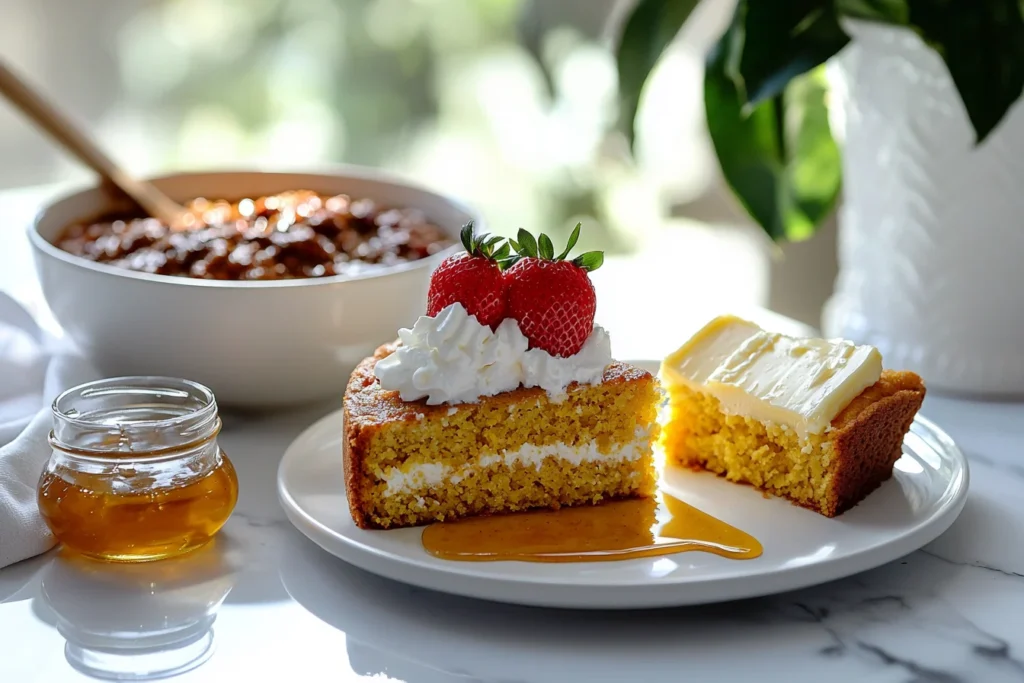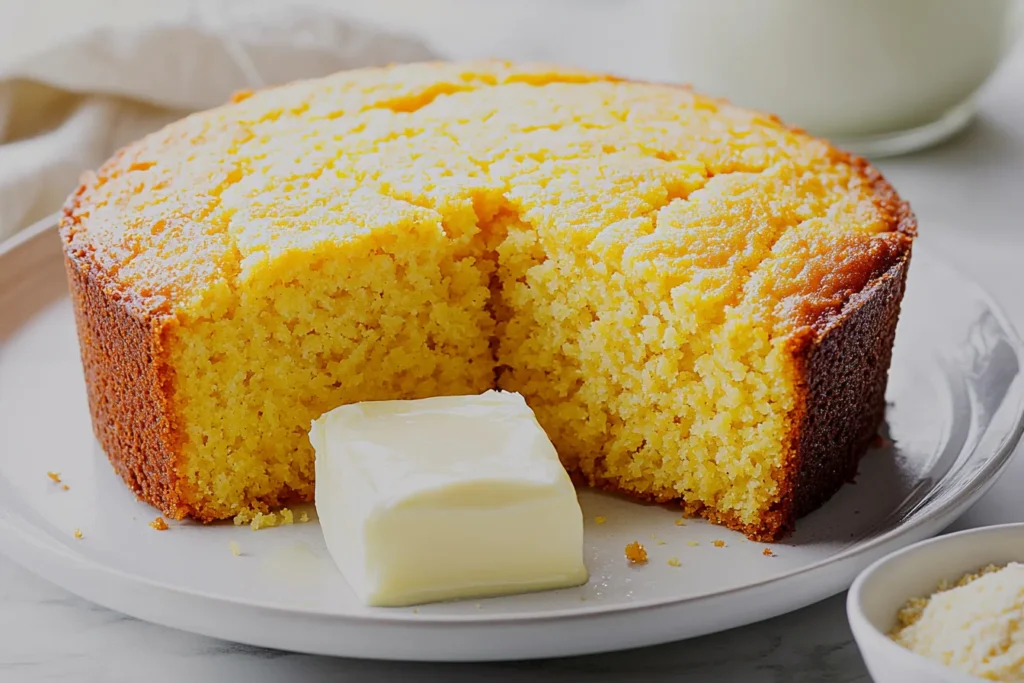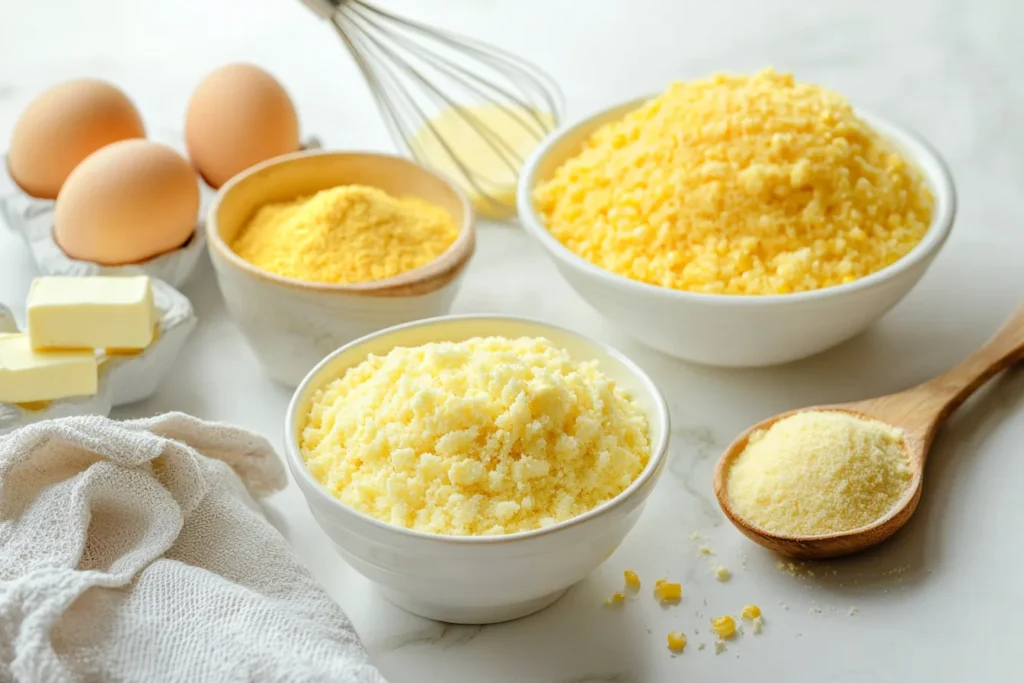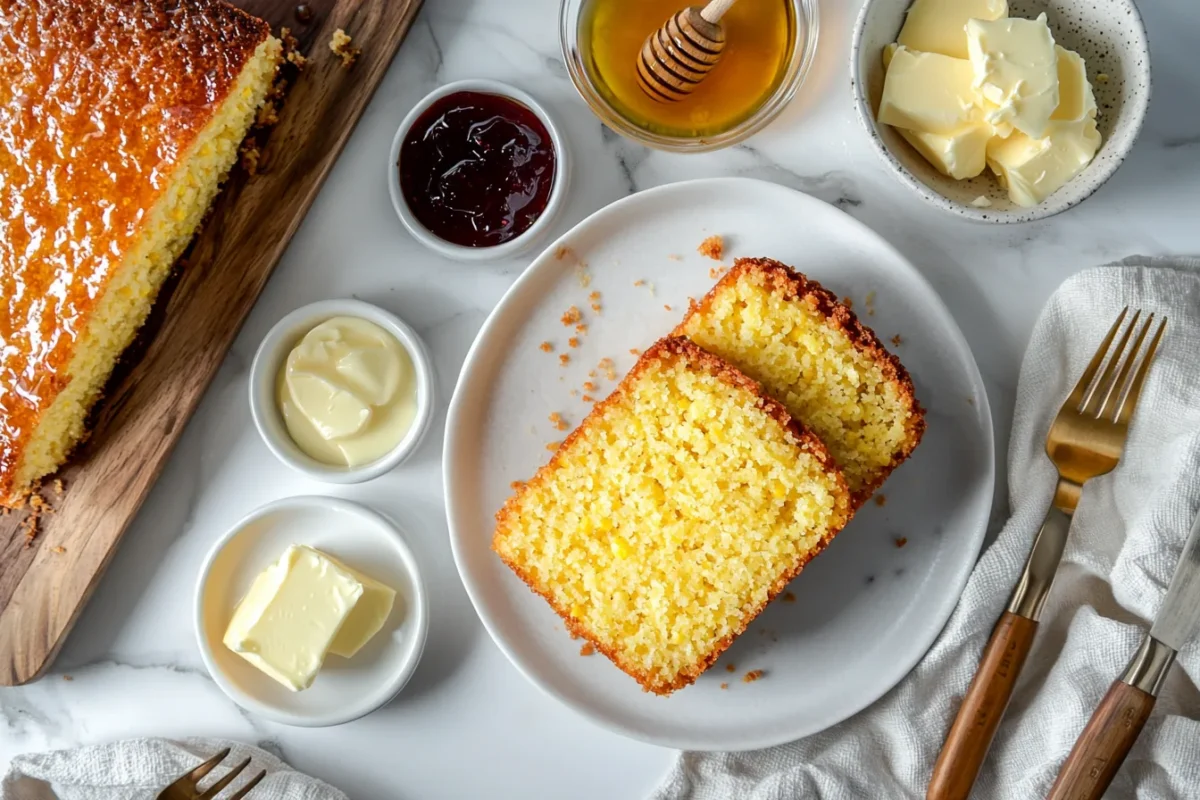Have you ever wondered what’s the difference between corn cake and cornbread? You’re not alone! Many people confuse these two delicious dishes, but they’re not as similar as they might seem. Whether you’re planning a cozy dinner or a festive gathering, knowing how they differ can help you make the perfect choice.
Corn cake is soft, moist, and sweet—think dessert vibes. Cornbread, on the other hand, is hearty, savory, and perfect for soaking up soups or stews.

Both are crowd-pleasers, but their unique textures and flavors make each one special in its own way.
Ready to discover which one fits your next meal? Stick around, because this fun guide breaks it all down. By the end, you’ll know exactly when to reach for corn cake or cornbread, and maybe even learn a new favorite way to enjoy them. Let us know your thoughts in the comments below—do you prefer the sweetness of corn cake or the savory charm of cornbread? Let’s get started!
Table of Contents
Understanding the Origins of Corn Cake and Cornbread
The historical roots of corn-based dishes
Corn has been a staple in many cultures for centuries. From Native American traditions to European settlers, corn played a central role in daily life. People learned to grind it into meal and create simple, nourishing dishes. One of the earliest forms of cornbread can be traced back to Native American cooking. They used basic ingredients like cornmeal and water to make bread that was easy to cook over an open fire. Recipes like the Southern cornbread recipe with beef tallow highlight how traditional methods continue to inspire modern interpretations of cornbread.
For more insights, check out the history of corn to explore how this essential crop shaped cuisines around the world.
Similarly, corn cake has historical significance in regions where sweeter flavors were preferred. Over time, both dishes evolved based on local preferences and available ingredients. First, settlers began adding ingredients like milk and eggs. Then, as sugar became more common, corn cake gained its signature sweetness. These dishes might share roots, but their unique paths show how food adapts and grows. So, what’s the difference between corn cake and cornbread? Let’s dive in and find out!
How cultural influences shaped corn cake and cornbread
Cultural traditions have always shaped the way we cook and eat. Cornbread and corn cake are no exceptions. In the southern United States, cornbread became a staple for its simplicity and savory flavor. Families would pair it with hearty dishes like beans or stews. Interestingly, many Southern recipes avoid sugar in cornbread, reflecting their preference for savory over sweet. If you’re curious, learn more about why Southerners don’t add sugar to cornbread and how this tradition evolved.
Meanwhile, regions with a preference for desserts leaned toward corn cake. Its sweetness made it a favorite for celebrations. As communities grew and shared recipes, each dish took on new forms. For example, Latin American countries introduced variations like arepas and sweet corn tamales. These global influences enriched the way corn was prepared. Today, the keyphrase what’s the difference between corn cake and cornbread still sparks curiosity. The history behind these dishes reminds us how food reflects culture and creativity. It’s amazing how one ingredient—corn—can tell so many stories!
Texture and Consistency: Key Differences Between Corn Cake and Cornbread
Exploring the softer, moist texture of corn cake
Corn cake is all about that soft and moist texture you just cannot resist. Unlike its crumbly counterpart, corn cake has a delicate, almost velvety consistency. This comes from its higher liquid content and the use of ingredients like milk, butter, and sugar.

These additions make it richer and more cake-like, which explains why it’s often enjoyed as a dessert. For an inspiring twist, explore how Cornbread Chocolate Cake combines the softness of corn cake with the indulgence of chocolate.
When you take a bite, it melts in your mouth, offering a smooth and sweet experience. This texture is perfect for pairing with jams or honey, adding even more sweetness to the dish. First, the batter is usually wetter than cornbread’s, which helps it bake into a softer treat. Then, as it cools, it retains that fluffy feel that makes it so satisfying. If you are wondering what’s the difference between corn cake and cornbread, the texture is definitely a key factor!
Why cornbread is known for its firm and crumbly bite
Cornbread is loved for its hearty, crumbly texture that pairs beautifully with savory meals. It is firm but never dry when made correctly. This texture comes from its simple ingredients like cornmeal, water, and sometimes buttermilk. Unlike corn cake, cornbread has less liquid and no added sugar, giving it that signature dense feel. For tips on achieving the perfect texture, check out What Ingredient Keeps Cornbread from Crumbling to enhance your next batch.
When you break apart a piece, it holds together but crumbles slightly, which is perfect for sopping up soups or stews. First, it is baked at a higher temperature to create a slightly crusty outer layer. Then, the inside stays tender enough to enjoy on its own or with butter. Cornbread’s rustic texture makes it a staple in traditional Southern cooking.

The difference in texture is one reason people still ask what’s the difference between corn cake and cornbread—and it’s all about personal preference!
Flavor Profiles of Corn Cake vs. Cornbread
Sweetness and other flavor notes in corn cake
Corn cake stands out for its rich, sweet flavor that feels like a warm hug in every bite. The sweetness comes from added sugar or even ingredients like honey or condensed milk, which give it that dessert-like quality. Its flavor is often enhanced with vanilla or a touch of cinnamon, making it a favorite for those who love a little indulgence. If you’re feeling adventurous, try a unique twist like Cornbread Chocolate Cake, where sweet and decadent flavors combine beautifully.
When you bite into corn cake, you might notice a hint of buttery richness that complements its sweetness. First, the sugar blends with the cornmeal, creating a balanced sweetness that is not overpowering. Then, the buttery notes add a satisfying depth to the flavor. The result is a dish that feels both comforting and a little decadent. If you have ever asked what’s the difference between corn cake and cornbread, the sweetness of corn cake is a clear and delicious answer!
The savory appeal of traditional cornbread
Cornbread is all about its earthy, savory flavors that highlight the natural taste of cornmeal. It’s the kind of food that pairs perfectly with chili, barbecue, or even a simple pot of beans. Traditional recipes skip the sugar, focusing instead on ingredients like buttermilk or bacon drippings for added flavor.
When you taste cornbread, you will notice its slightly nutty and toasty undertones. First, the cornmeal gives it a naturally hearty flavor. Then, additions like a sprinkle of salt or even a touch of butter enhance its savory profile. This balance makes cornbread versatile and ideal for savory dishes. Its flavor contrasts sharply with the sweetness of corn cake, making it a go-to option for anyone who prefers a less sugary bite. Wondering what’s the difference between corn cake and cornbread? The flavors couldn’t be more distinct!
Traditional Uses and Occasions for Corn Cake and Cornbread
Celebratory dishes featuring corn cake
Corn cake often shines as the star of festive gatherings and celebrations. Its sweet and moist texture makes it an ideal dessert option for family meals, birthdays, and holiday parties. In some cultures, it’s even a traditional treat for special occasions like weddings or harvest festivals.
First, the cake’s sweetness pairs perfectly with toppings like whipped cream, fresh fruit, or a drizzle of honey. Then, its delicate crumb makes it easy to slice and serve, whether at a large party or a cozy get-together. Many people enjoy corn cake alongside coffee or tea, making it a versatile choice for any time of day. If you’re wondering what’s the difference between corn cake and cornbread, its role as a celebratory dish is a big clue. Corn cake always adds a little extra joy to the table!
Everyday meals complemented by cornbread
Cornbread, on the other hand, is a workhorse of everyday cooking. Its savory flavor and firm texture make it the perfect side dish for hearty meals. You’ll often find it served alongside chili, stews, or barbecued meats, where it soaks up sauces, balances flavors, and adds a satisfying bite.
First, its simplicity makes it quick and easy to prepare. Then, its rustic charm adds a comforting, home-cooked feel to any meal. Cornbread is also great on its own, served warm with a pat of butter or a drizzle of honey for a quick snack. Some even enjoy adding extra ingredients like jalapeños or cheese for a unique twist. Unlike corn cake, which often feels like a treat, cornbread fits effortlessly into everyday meals. So, what’s the difference between corn cake and cornbread? Cornbread is the practical, savory staple that completes your plate!
Ingredient Variations That Set Corn Cake and Cornbread Apart

Common ingredients in corn cake recipes
Corn cake recipes are all about creating a moist and sweet treat. The key ingredients usually include cornmeal, sugar, butter, milk, and eggs. These combine to give corn cake its rich texture and dessert-like flavor. Some recipes even add extras like vanilla, honey, or condensed milk to make it even more indulgent.
First, the sugar plays a big role in creating the sweetness that sets corn cake apart. Then, the butter and milk add a creamy richness that enhances its moist texture. For an extra twist, some cooks add cinnamon or nutmeg for warmth. Corn cake is versatile enough to adapt to different flavor preferences. Whether you make it plain or fancy it up with toppings like whipped cream or berries, the result is always delicious. If you’re asking what’s the difference between corn cake and cornbread, these ingredients make corn cake truly stand out.
Distinctive elements in cornbread preparation
Cornbread, in contrast, keeps things simple and savory. Its core ingredients include cornmeal, flour, buttermilk, eggs, and sometimes a bit of baking powder. These create its crumbly texture and earthy flavor. Unlike corn cake, sugar is optional or used sparingly, keeping the focus on the natural taste of the cornmeal.
First, the buttermilk adds a slight tanginess that enhances the overall flavor. Then, the eggs and baking powder work together to give it a light and airy texture without being too soft. Many recipes also call for cooking cornbread in a cast-iron skillet, which helps create that classic golden crust. Some cooks even add jalapeños, cheese, or bacon for an extra kick. So, what’s the difference between corn cake and cornbread? The savory simplicity of cornbread’s ingredients makes it a perfect complement to hearty meals.
Modern Twists on Corn Cake and Cornbread
Creative variations of corn cake in contemporary cuisine
Corn cake has come a long way from its traditional roots, inspiring countless creative twists in modern kitchens. Today, chefs and home cooks alike experiment with unique flavors and ingredients to make corn cake even more exciting. For instance, some add coconut milk or pineapple for a tropical flair, while others mix in chocolate chips for a dessert-friendly treat.
First, these variations highlight how versatile corn cake can be. Then, innovative toppings like caramel drizzle, fruit compote, or even a dusting of powdered sugar make it a showstopper on any table. Some people also experiment with savory versions, adding cheese or herbs for a surprising twist. Whether you stick to the classic or try something new, corn cake always delivers. If you’ve been asking what’s the difference between corn cake and cornbread, these creative takes on corn cake show just how flexible and fun it can be!
Innovative ways to enjoy cornbread
Cornbread is no stranger to reinvention either, with modern cooks finding fresh ways to make it stand out. From jalapeño and cheddar cornbread muffins to cornbread waffles topped with chili, the possibilities are endless and keep the dish evolving. These creative spins breathe new life into this classic dish, keeping it fresh, exciting, and perfect for today’s tables.
First, swapping traditional ingredients with options like gluten-free flour or vegan alternatives makes cornbread accessible to everyone. Then, experimenting with bold add-ins like sun-dried tomatoes, roasted garlic, or fresh herbs takes it to the next level. Cornbread also works as a base for casseroles or stuffing, proving its versatility time and time again. Wondering what’s the difference between corn cake and cornbread? These modern takes on cornbread show how it remains a savory favorite while adapting to new culinary trends.
Frequently Asked Questions (FAQs)
Is cornbread the same as corn cake?
Cornbread and corn cake are similar but have clear differences. Cornbread is savory, often served as a side with hearty meals like chili or barbecue. It has a firm, crumbly texture and usually lacks the sweetness found in corn cake. Corn cake, on the other hand, is sweet, moist, and more like a dessert.
The main differences come down to the ingredients and flavor. Cornbread uses little or no sugar, while corn cake adds sweetness with sugar or honey. Both are tasty, but they’re not the same. Choose based on whether you want savory or sweet!
What’s the difference between cornbread and corn pone?
Cornbread and corn pone may sound similar, but they are not the same. Cornbread is a lighter, crumbly dish often baked in an oven and served alongside savory meals. It typically includes ingredients like eggs, milk, and sometimes a little sugar, making it fluffier and less dense.
Corn pone, on the other hand, is denser and made with just cornmeal, water, and fat like lard or butter. It’s usually fried or baked in a skillet, giving it a crispy exterior. The key difference is the texture and preparation style. Corn pone is rustic and hearty, while cornbread feels lighter and slightly more refined.
What is another name for corn cake?
Corn cake goes by several other names depending on where you are. In some regions, people call it sweet corn pudding because of its rich, moist texture. Latin American cuisines feature similar dishes, like arepas de choclo or pastel de elote, which translate to “corn cakes.” Meanwhile, in Southern cooking, it’s often referred to as spoonbread when it’s extra soft and creamy.
Another common name is sweet corn bread, though this version is sweeter and more dessert-like than traditional cornbread. No matter the name, corn cake always delivers a sweet, delicious treat!
Is there a difference between cornmeal and cornbread?
Yes, there is a big difference between cornmeal and cornbread. Cornmeal is an ingredient made by grinding dried corn into a fine or coarse texture. It’s used in various recipes, including cornbread, tortillas, and even pancakes. Cornmeal itself is not a dish; it’s a versatile base for creating many meals.
Cornbread, on the other hand, is a finished baked dish made with cornmeal. It includes additional ingredients like eggs, milk, and sometimes sugar, giving it a distinct flavor and texture. So, while cornmeal is an ingredient, cornbread is the tasty result of using it!
Choosing Between Corn Cake and Cornbread: Which One’s Right for You?
Deciding between corn cake and cornbread depends on what you’re craving and the occasion. If you’re in the mood for something sweet and moist, corn cake is your go-to. It’s perfect for celebrations, desserts, or just when you want a little indulgence. Pair it with toppings like whipped cream or fruit, and you’ll have a treat everyone loves.
On the other hand, cornbread is ideal for savory meals and everyday cooking. It’s firm, hearty, and pairs well with dishes like chili, soups, or barbecue. You can even get creative by adding jalapeños or cheese for extra flavor. Both dishes have their charm and bring something unique to the table.
So, what’s the difference between corn cake and cornbread? Now you know! Try them both, and find your favorite. Your taste buds will thank you!

